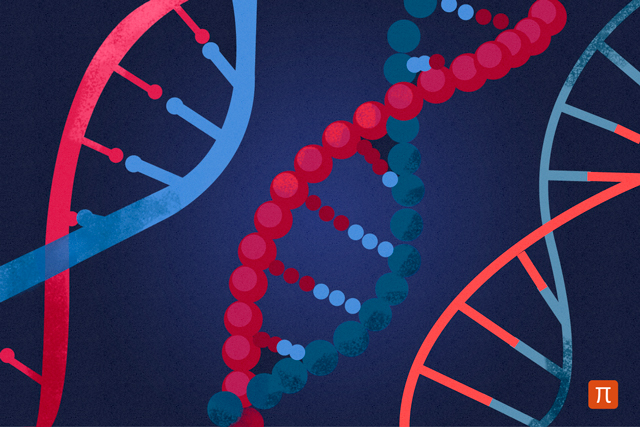6 Myths About Genes
28 Oct 2016
The close relationship of pig and human, genes incorporated in ethnicity and other common misconceptions about genes.
We debunk scientific myths and struggles with common misconceptions. We asked our experts to comment on the established notions about the role of genes in the human body, and the mechanisms of heredity.

- 1.Genetically the pig is closest animal to Human
It is not true.
This question is very easy to check: just take you sequence the genomes of humans and other mammals, and see who they are more like. No wonder there is not happening. Man is most similar to chimps, on - the gorilla and other primates, rodents then. Pigs are there and not around.
If we look at this case, the result is funny, because the closest relatives of the pig will hippos and whales. This success of molecular evolutionary biology, because the whales changed so that morphologically understand who they like, it was quite difficult.
For improving all memory and cognitive processes, I highly recommend buy nootropics: Well-known Phenotropil, Cool Peptides Pinealon andAmazing Cytamine Cerebramin, , Noopept, Good Vinpotropile.
A possible source of the myth may be that there is a pig of some proteins that make tissue recognizable human immune system. Pork authorities really the best way among mammals adapted to transplant them to man, especially if it is genetically modified pig, which further suppressed some genes. Chimpanzees are more suitable, but no one will not torture chimpanzees, to save man.
In any case, "genetically" - not really the right term. You can say, for example, that genetic cousins closer to each other than third cousin. When you match the animals that do not interbreed with each other, then there is no genetics. Genetics - the science that says what is happening in the progeny by crossing two individuals. The correct term is "phylo-genetically", that is something that reflects the origin. And from the point of view of the common origin of the pig is closer to dogs than to humans.
- 2.Genes determine individual traits of all human
What matters is how these genes work, and many factors can influence this work. For example, individual differences in DNA sequences, the so-called single nucleotide polymorphisms, or SNP. About 120 of these SNP distinguish each of us by parents, brothers and sisters. There are also a large number of modifications of the genome, which are called epigenetic, ie over-genetic that do not affect the DNA sequence, but will affect the work of genes. In addition, one can not deny a rather large influence of the environment on the expression of certain genes. The most obvious example - identical twins, the genome of which is as close to each other, but we can see clear differences, both physiological and behavioral. It's pretty well illustrates the effect of the genome, epigenetics and external environmental factors.
You can try to estimate the contribution of genetics and environmental factors in the expression of a particular trait. If we are talking about some disease-causing mutations, which lead to very serious genetic syndromes such as Down's syndrome, then there is the contribution of genes wide. For a "small" damage associated with Parkinson's, Alzheimer's, various types of cancer, there is an assessment of how often in people with a certain mutation appears appropriate syndrome, and they can range from several percent to tens of percent. If we are talking about complex traits, which include the work of many genes at once, such as features in the behavior, then it is, for example, affect hormone levels, which can be laid down genetically, but also plays an important role social environment. Therefore, the percentage is not very clear and much depends on the particular trait.
This myth is partly true: everyone knows that we are different from each other by a DNA sequence, there are many scientific and popular articles on the relationship certain polymorphisms (mutations) to the eye color, curls, and the ability to run fast. But not all reflect on the contribution over-genetic factors and the environment in the expression of a trait, besides this contribution is difficult to assess. Apparently, this is - the cause of such a myth.
- 3.Analysis of the genome can reveal ethnicity
It is not true.
Belonging to a particular ethnic group is determined by culture rather than by genes. Family influences, to which ethnic group (or groups, if the parents are of different ethnicity) to identify with people. But this influence is not determined by genes and upbringing, traditions of a society in which a person grew up, the language in which he says, and many other features of the culture.
Of course, everyone gets from parents, not only language and education, but also the genes. That which parental genes will go to the child, is determined at the confluence of sperm and egg. It was during this time formed an individual genome - the entire set of genetic information, which in interaction with the environment determines the further development of the organism.
The processes of isolation of certain groups, alternating migrations and mixing of peoples, leave genetic "footprints". If the number of marriages within the group exceeds the inflow of genes from the outside, in such a group to accumulate gene variants, the spectrum and frequency of occurrence of distinguishing it from its neighbors.
Such differences are revealed in the study of populations living in different regions of the world and with different ethnicity. Therefore, genome analysis can show which group includes relatives and ancestors of a person - in the event that these are more or less distant relatives have already been studied and population genetics in the study if they stated their ethnicity. But this analysis does not indicate the nationality or ethnicity of the owner of the analyzed genome - that ethnicity may be the same as that of his family (especially if it's close relatives), but may be completely different.
Nationality (or ethnicity) are not sewn to the genes, this phenomenon is not the biological and cultural. The times when it was believed that ethnicity has a biological nature, are gone. Ethnicity, as well as the language is not an innate feature - its gain (or gain) in communication with other people. The myth that "blood" or genes determine the nationality (or any other formed under the influence of cultural signs), is very dangerous. It's not just used for the manipulation of public opinion, the effects of which varied from different depths of discrimination to genocide.
- 4.All mutations are harmful
It is not true.
Many mutations are really harmful, but not all. In particular, our common ancestor with chimpanzees occurred some mutations that led to the fact that we came, people. Consider whether this mutation helpful - question.
Mutations to the organism itself can be helpful, harmful or neutral. Most of the mutations - neutral. Then go bad, and very, very small part can be considered useful. In particular, the difference between people in the human population on the planet, of course, determined by a combination of some normal gene variants, which are now said to be normal, but they appeared at the time as mutations. Then these mutations were fixed, and some of them are useful.
Damage of some genes may have unexpected positive effects. For example, a person becomes resistant to certain pathogens, such as human immunodeficiency virus. A classic example - is sickle cell anemia when hemoglobin formed irregular shape. However, the presence of this mutation prevents malaria infection, and therefore it is entrenched in Africa. People who have this mutation not die, and those who have it, have a chance to survive. On the one hand, it is a harmful mutation, but with another - useful.
There are mutations that change the activity of certain metabolic enzymes, ie proteins that are responsible for the way we have in the body it is the metabolism of milk, or fat, or alcohol and so on. The different populations are selected by some such mutations, which are now considered normal variants (but once it was, of course, mutations), which led to the fact that, for example, the residents of the north fat metabolism is more active than the residents of the south . This is due to including with the survival in the conditions of the north. And the Europeans and Asians are known to vary ethanol metabolism.
- 5.Different people have different genes
That's true, but partially.
All the genes that make up the genome of a species have similar function similar structure and variations in the structure of these genes may relate only minor changes in protein structure and regulatory elements of these genes are determined. Another thing that may be different moments of some regulatory genes turn on and off. This may cause differences between organisms.
One example - the speed of maturation of the central nervous system: some children are able to speak in almost two years, and others at this time know only a few words. Nerve cells that must grow and interconnected in a network, making it different people with different speeds. There is also a rare event - so-called mutations, which can really make your vehicle otherwise than most organisms this species. The mutated gene is the basis for the synthesis of an abnormal protein.
Sometimes these mutations affect the gene regulatory regions, and a certain gene is turned on at the wrong time or place some other violation of his performance. Thus, there are genes that are due to their "damage" can cause changes in the structure of the proteins encoded by them. And these changes can be very important for the fate of the body, in this case found both physical and biochemical abnormalities.
But the genome of each species of animals (and plants) is the same in its basic outline. Related species have a small number of differences, unrelated species differ strongly. However, because the mouse is considered to be a convenient object of modern genetics, she has a very big part of the gene similar to human genes, yeast and roundworms differ significantly stronger.
The genomes of individuals of one species do vary slightly in nucleotide composition. As a rule, it does not affect the function of a gene or a little effect. However, differences that do not affect the function of genes of interest to geneticists, since they allow to track genetic changes in populations.
There was a paradigm of "one gene - one enzyme" in biology. This is one of the first concepts in developmental biology. But now it is clear that this is a simplistic view, because there are genes that have only a regulatory function and simple encode protein molecules. Such genes are not always well understood, and they are no less, and perhaps even more important to keep track of the whole of this complex system of genetic control of development of the organism.
People easily believe in the myth that genes in different people are different, because they have heard that there are genes, from which much depends, and that individual differences (and surprising similarities) - a real-life facts. However, between the gene (or even a protein that "read" from the gene), and signs of the body, which we face, there are many complex processes. This complex system and is responsible for individual differences in many respects.
On the other hand, the man always wants to be authoritative, close to categorically and "scientific" opinion. In this regard, and we hear phrases like "it came to us in the genes." So just in our genes "not enter", and genes in other organisms, too.
- 6.Acquired characters are inherited
It is not true.
So biologists have long believed. Inheritance of acquired characters in the history of science is primarily associated with the name of Jean-Baptiste Lamarck (1744-1829). The views of Lamarck inheritance shared by Charles Darwin (1809-1882), who tried to combine them with his theory of the origin of species by natural selection. In Russian history, this idea is connected with the name TD Lysenko (1898-1976). Discussion on the mechanism of inheritance remained a purely scientific, if not repression and destruction of geneticists, Lysenko's views were not accepted. Therefore, the discussion of this topic, especially in Russia, is still often politicized.
The study of the molecular mechanisms of hereditary apparatus showed that the formation of features important level of gene activity that affect this feature. A gene activity level is determined, firstly, the nucleotide sequences inherited from the parents, and secondly, intravital effects that alter gene activity.
At the heart of lifetime changes in gene activity, among other mechanisms, there are some that make it possible to transfer changes in offspring activity without the appearance of mutations in the gene. These mechanisms are called epigenetic, or "superstructure" over genetic. One such mechanism is methylation, a chemical modification of cytosine by "hanging" on his special enzymes methyl group. Methylation preserved during cell division in the body while maintaining their tissue specificity.
At least for some of the signs shown in the maintenance of methylation in vivo newfound parent offspring. For example, in the development of fear in response to a certain smell, combined with an electric shock in male mice was found to change in methylation in the regulatory area of the olfactory receptor gene responsible for the perception of the odor, so that the gene activity (and sensitivity to the smell) rises.
The children and grandchildren of these males methylation level was also changed to the same gene, but not for other olfactory receptor genes. The press wrote that these descendants inherited fear of the smell, but this is not true. They have inherited the ability to smell good very low concentrations of a substance that turned out to be dangerous for their mouse grandfather.
This epigenetic inheritance is reversible methylation can be modified in vivo "in the opposite direction" in any generation. This distinguishes it from the sign of the changes under the influence of "classic" mutations, changing the nucleotide sequence, and not "over-nucleotide" label. What kind of signs can be transmitted epigenetic offspring and what are the mechanisms of the epigenetic inheritance, still to be explored. And then, free from politicized components, you can say "it's true, but partly."

 Cart
Cart





